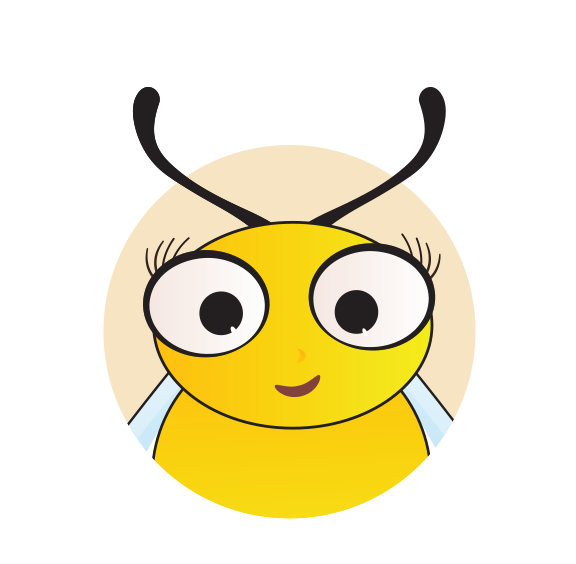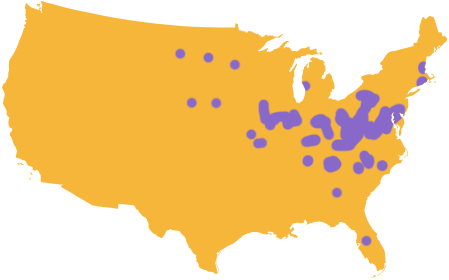Fun Facts about the Mining Bee
Unlike her honey bee relatives, the mining bee forgoes colony living and strikes out on her own. Having loaded up her hind legs with pollen, she flutters a few inches above the ground, searching for sandy soil to form her nest. Using her legs, she clears out a deep burrow. Within the burrow she creates individual cells. Within a cell a single, small egg is laid. The female adds to the cell a ball of pollen and nectar to the cell as food. The egg and its food are sealed off, safe in the underground cocoon provided by the mother. The mining bee then crawls her way back out into the world to find more food for the rest of her young.
This solitary living means lots of hardship and uncertainty for our mining bee, as she is solely responsible for fending off predators and finding enough food for her offspring. Where she benefits from being alone is in being in control of her own reproduction. While most of the females in a honey bee colony will never lay a single egg, every mining bee female has the opportunity to breed.
Classification:
- Order: Hymenoptera
- Family: Andrenidae
- Subfamily: Andrena
- Genus: Melandrena
- Species: pruni
Distinguishing features:
Buzzing about sandy soil where their nests are located
Strength:
Most bees are fairly tough but mining bees are especially strong because they need to dig through the dirt. But though they might be tough, they rarely sting.
Speed:
Bees are excellent fliers, zipping from flower to flower.

Photo by Graham Montgomery
Susan: Welcome to Insect Interviews. The show where you get to meet your favorite bugs from your backyard to across the globe. I’m your host Dr. Susan and I have a very special guest today - Becky the Bee! Becky how are you on this Sunny day?
Becky? …Becky?
Becky: Sorry about that. I was distracted by all the flowers in my dressing room. When the flowers are in bloom I spend almost all of my time collecting pollen. I simply can’t get enough! I love it!
Susan: I completely understand. Thank you for taking the time to talk today. Our listening audience is eager to learn more about you. Can you tell everyone a little about yourself?
Becky: Hi everybody! My name is Becky and I’m a BEE! Did you know there are lots of different kinds of bees?
Susan: Really?
Becky: Yup, there’s bumble bees and carpenter bees and digger bees and cellophane bees and cuckoo bees and Mason Bees and about 25,000 other types of bees.
Susan: Wow! That’s a lot of bees.
Becky: Tell me about it. Guess what kind of bee I am?
Susan: Hmmm, well… you look like a honey bee, but it seems like you’re missing those special pollen catchers.
Becky: Yup, the back legs of honey bees have sort of a basket they use to put their pollen in.
Susan: Ah, yes, now I remember. Humans call that special basket a corbicula. Did you lose your corbicula?
Becky: Nope! I’ve never had one silly. I’m a mining bee. I collect pollen like honey bee, but I don’t use a basket. I have these cool hairs on my back legs that the pollen sticks to.
Susan: Those pollen collecting hairs are super cool. If I’m not mistaken, we call those hairs scopa
What do you do with all the pollen you collect?
Becky: I bring all the pollen back to my house. My house is a tiny nest I made underground. It’s the perfect place to store my pollen so my kids can eat it to grow big and strong.
Susan: Did you make your house all by yourself or did you have help from a colony like the honey bee?
Becky: No, no, no. I do this all on my own! I build my nest, collect my own pollen, and take care of my baby bees until they are old enough to move into their own nest.
Susan: Wow, that’s great! I never knew a single bee could accomplish so much. Becky, I can’t thank you enough for taking time out of your busy schedule to teach us about the life of a Mining Bee. Beelieve me, I’m not pollen your chain, I’ve had an unbeeeelievably fun time!
Becky: Your silly Dr. Susan.Thank you for having me, but it’s time for me to buzzzzzz off. Bye!
- Attracting Native Polllinators by The Xerces Society
- Bees: Nature’s Little Wonders by Candace Savage
- Bees, Wasps, and Ants: the Indispensable role of Hymenoptera in Gardens by Eric Grissell
- The Bees of the World by Charles Michener
- Insects: Their Natural History and Diversity by Stephen Marshall


